CADILLAC FLEETWOOD 1993 2.G Owners Manual
Manufacturer: CADILLAC, Model Year: 1993, Model line: FLEETWOOD, Model: CADILLAC FLEETWOOD 1993 2.GPages: 386, PDF Size: 19.17 MB
Page 101 of 386
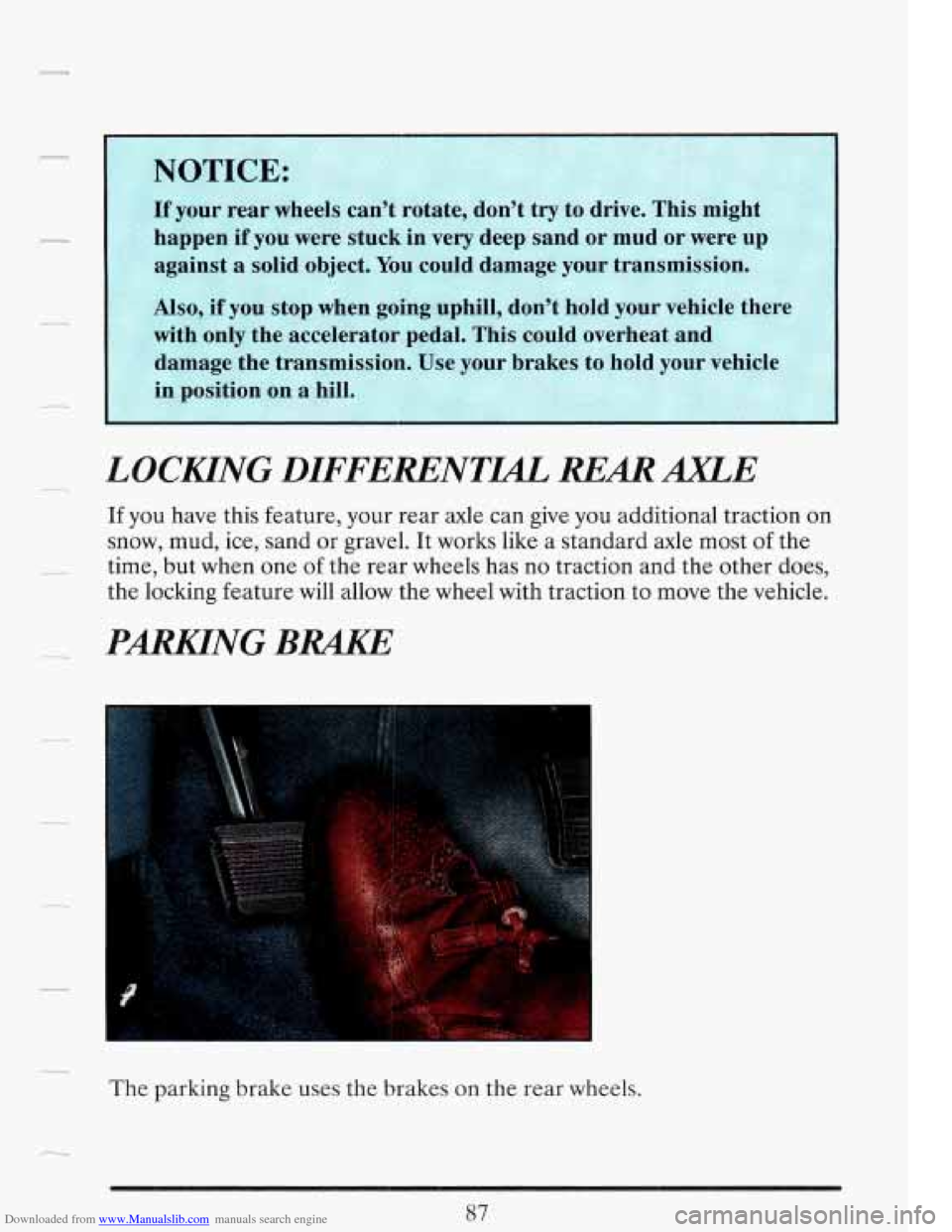
Downloaded from www.Manualslib.com manuals search engine r
NOTICE:
If your rear wheels can’t rotate, don’t try to drive. This might
against
a solid object. You could damage your transmission.
- happen if you were stuck in very deep sand or mud or were up
Also, if you stop when going uphill, don’t hoh’
with only the accelerator pedal. This could
01
damage the transmission. Use your brakes ta
in position on a hill.
I. 1 ..
-
- I
LOCHNG DIFFERENTm REAR AXLE
If you have this feature, your rear axle can give you additional traction on
snow, mud, ice, sand or gravel. It works like a standard axle
most of the
time, but when one
of the rear wheels has no traction and the other does,
the locking feature
will allow the wheel with traction to move the vehicle.
PmNG BRAKE
-
The parking brake uses the brakes on the rear wheels.
Page 102 of 386
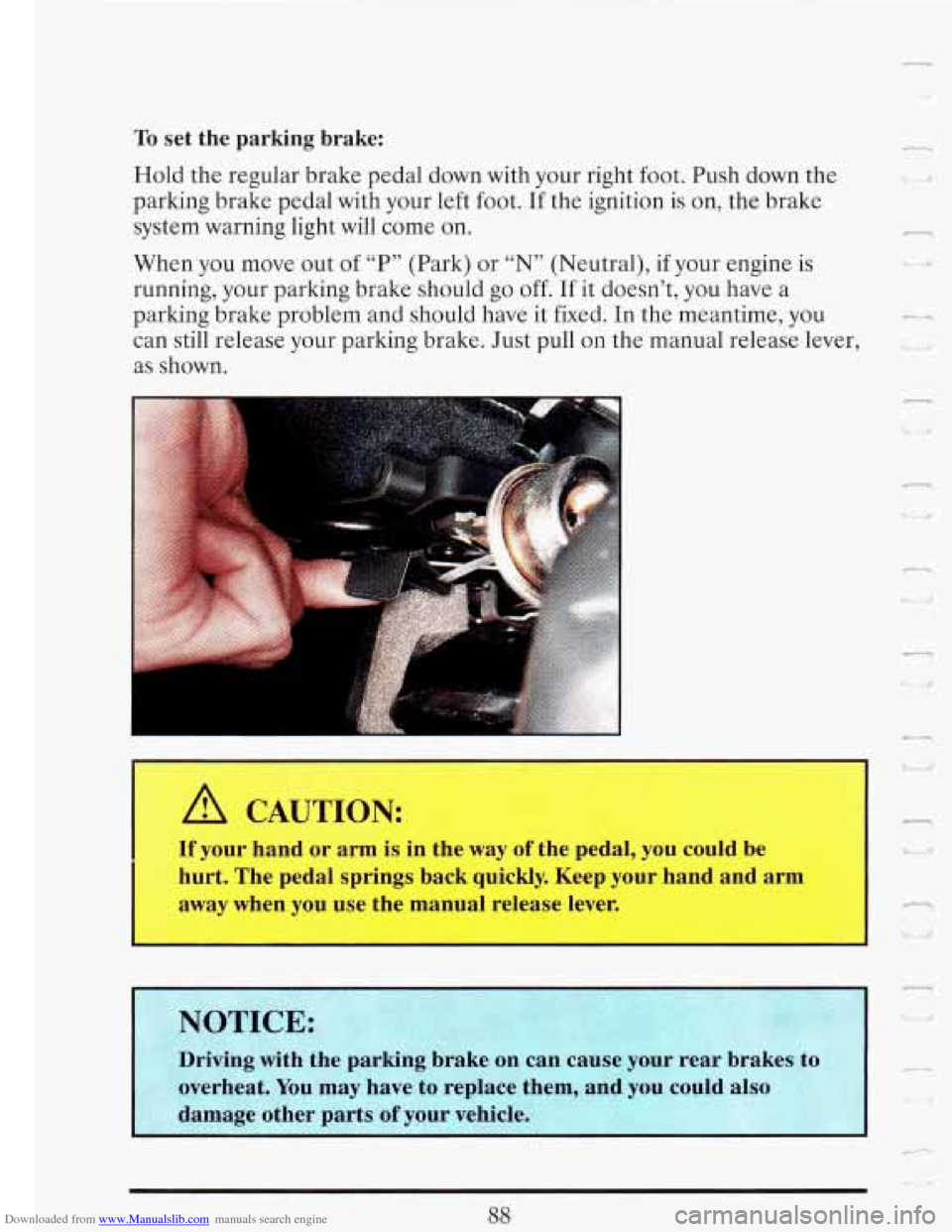
Downloaded from www.Manualslib.com manuals search engine To set the parking brake:
Hold the regular brake pedal down with your right foot. Push down the
parking brake pedal with your left foot. If the ignition is
on, the brake
system warning light will come
on.
When you move out of “P” (Park) or “N” (Neutral), if your engine is
running, your parking brake should go off. If
it doesn’t, you have a
parking brake problem and should have it fixed.
In the meantime, you -
can still release your parking brake. Just pull on the manual release lever, ,
as shown.
P
u I’
A CAUTION:
If your hand or arm is in the way of the pedal, you could be I
hurt. The pedal springs back quickly. Keep your hand and arm
away when you use the manual release lever.
NOTICE:
Driving with the parking brake on can cause your real ulakes to
overheat. You may have to replace them, and you could also
I
r
‘i ,,
I damage other parts of your vehicle. I
I
Page 103 of 386
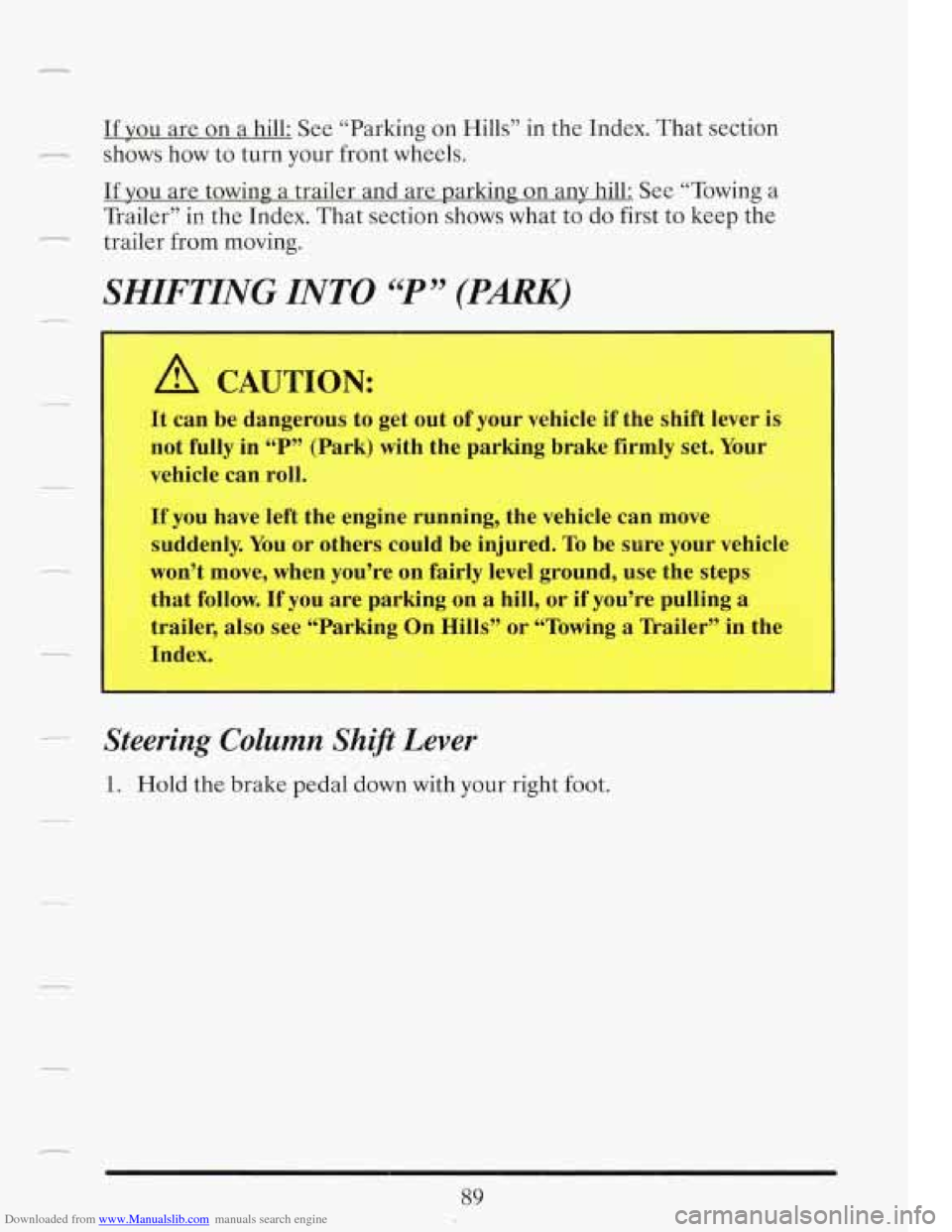
Downloaded from www.Manualslib.com manuals search engine If vou are on a hill: See “Parking on Hills” in the Index. That section
shows how to turn your front wheels.
If you are towing a trailer and are parking on any hill: See “Towing a
Trailer”
in the Index. That section shows what to do first to keep the
trailer from moving.
SHIFTING INTO “P” (PARK)
I A CAUTION:
It can be dangerous to get out of your vehicle if the shift lever is
not fully in
“P” (Park) with the parking brake firmly set. Your
vehicle can roll.
If you have left the engine running, the vehicle can move
suddenly. You or others could be injured. To be sure your vehicle
won’t move, when you’re on fairly level ground, use the steps
that follow.
If you are parking on a hill, or if you’re pulling a
trailer, also see “Parking On Hills” or “Towing a Trailer” in the
~ Index.
Steering Column Shift Lever
1. Hold the brake pedal down with your right foot.
89
Page 104 of 386
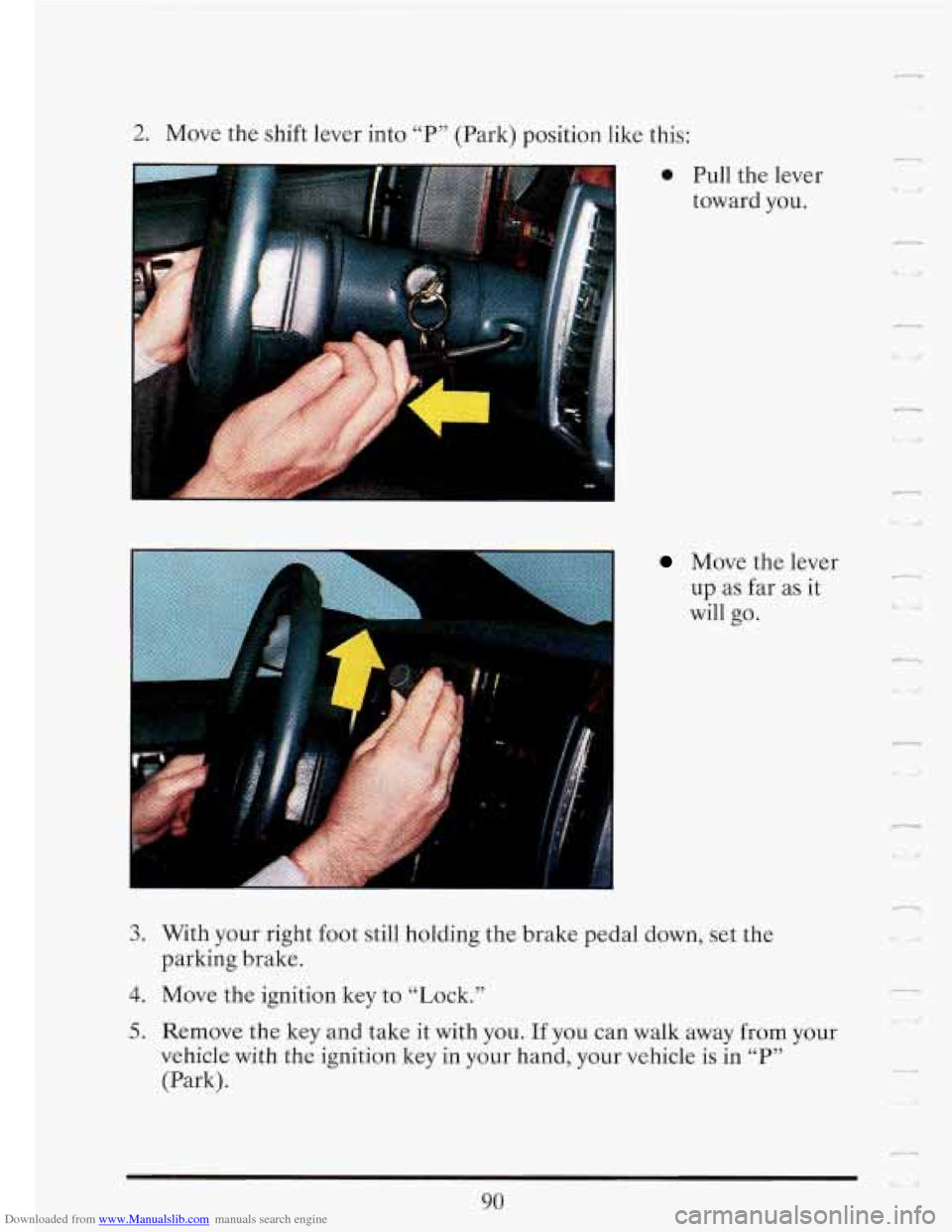
Downloaded from www.Manualslib.com manuals search engine 2. Move the shift lever into “P” (Park) position like this:
0 Pull the lever
toward you.
Move the lever
up as
far as it
will go.
n
W
3. With your right foot still holding the brake pedal down, set the
4. Move the ignition key to “Lock.”
parking brake.
5. Remove the key and take it with you, If you can walk away from your
vehicle
with the ignition key in your hand, your vehicle is in “P7’
(Park).
90
Page 105 of 386
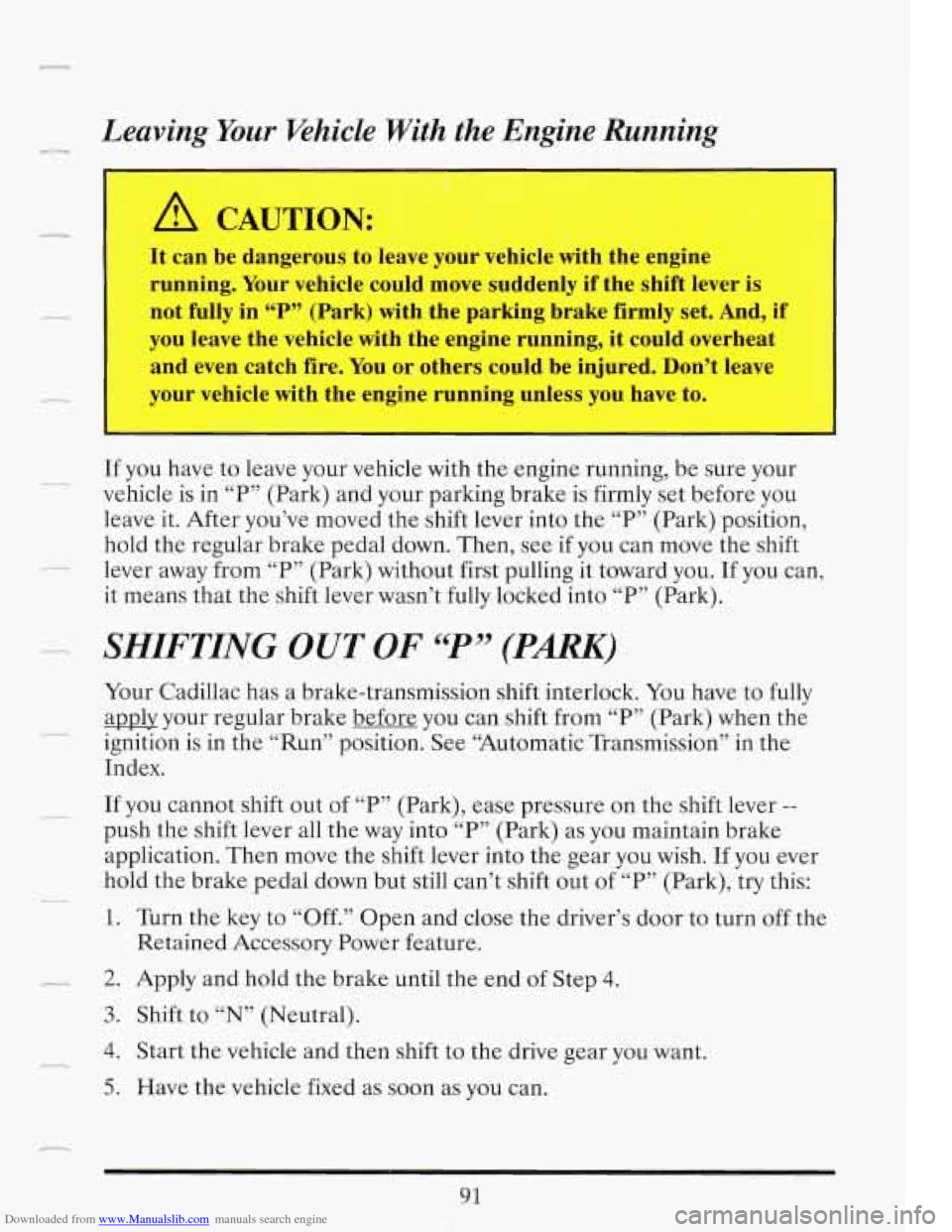
Downloaded from www.Manualslib.com manuals search engine Leaving Your Pkhicle With the Engine Running
----
A CAUTION:
It can be dangerous to leave your vehicle with the engine
running. Your vehicle could move suddenly if the shift lever is
not fully in “P” (Park) with the parking brake firmly set. And, if
you leave the vehicle with the engine running, it could overheat
and even catch fire. You or others could be injured. Don’t leave
your vehicle with the engine running unless you have to.
If you have to leave your vehicle with the engine running, be sure your
vehicle is in “P” (Park) and your parking brake is firmly set before you
leave it. After you’ve moved the shift lever into the “P” (Park) position,
hold the regular brake pedal down. Then, see if you can move the shift
lever away from “P” (Park) without first pulling it toward you. If you can,
it means that the shift lever wasn’t fully locked into “P” (Park).
SHIFTING OUT OF “P” (PARK)
Your Cadillac has a brake-transmission shift interlock. You have to fully
apply your regular brake before you can shift from “P” (Park) when the
ignition is in the “Run” position. See “Automatic Transmission” in the
Index.
If you cannot shift out of “P” (Park), ease pressure on the shift lever --
push the shift lever all the way into “P” (Park) as you maintain brake
application. Then move the shift lever into the gear you wish.
If you ever
hold the brake pedal down but still can’t shift out
of “P” (Park), try this:
1.
2.
3.
4.
5.
Turn the key to “Off.” Open and close the driver’s door to turn off the
Retained Accessory Power feature.
Apply and hold the brake until the end of Step
4.
Shift to “N” (Neutral).
Start the vehicle and then shift to the drive gear you want.
Have the vehicle fixed as
soon as you can.
91
Page 106 of 386
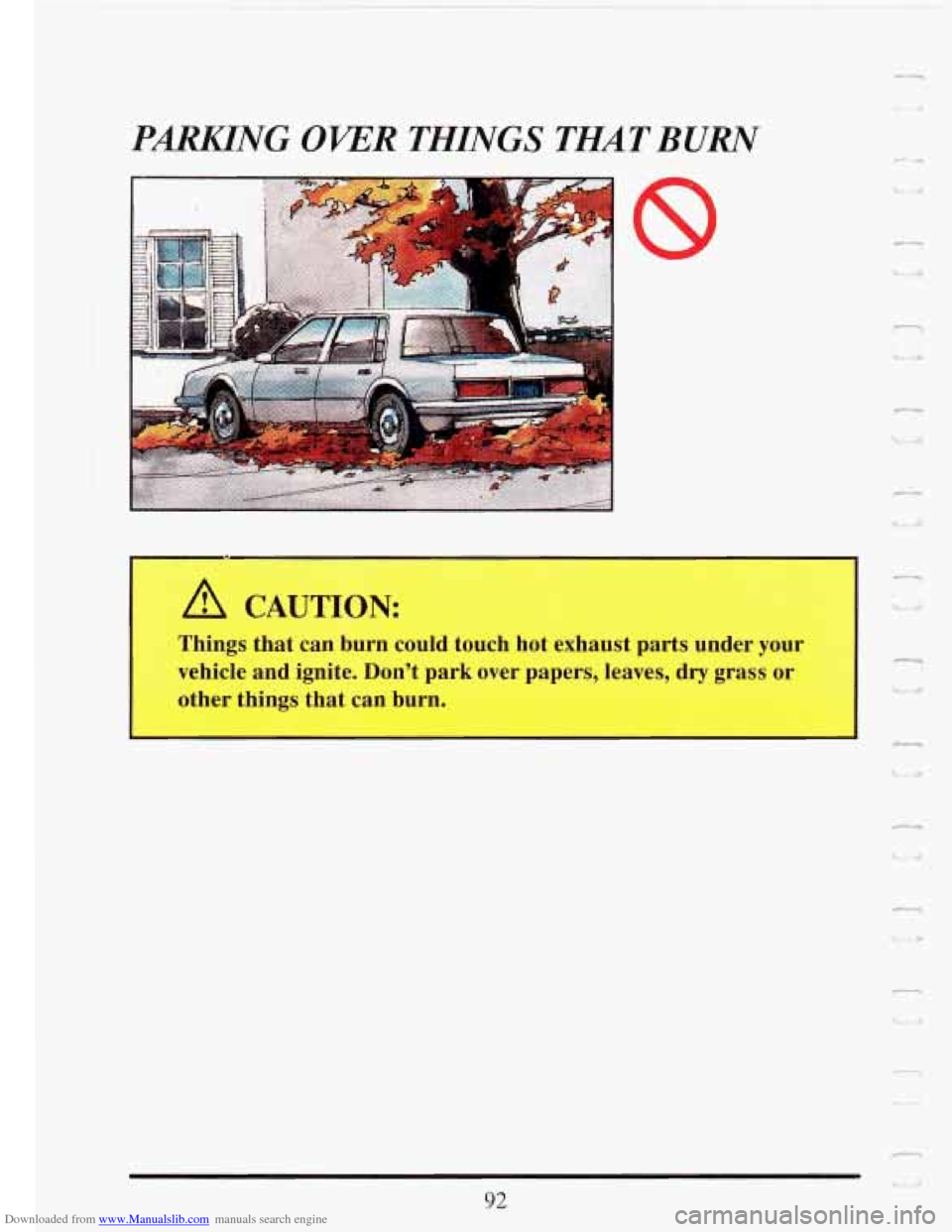
Downloaded from www.Manualslib.com manuals search engine PARKING OKER THINGS THATBURN
8
I
A
Things that can burn could touch hot exhaust parts under your
vehicle and ignite. Don't park over papers, leaves, dry grass or
D
other things that can burn. L.. -#
92
iL
Page 107 of 386
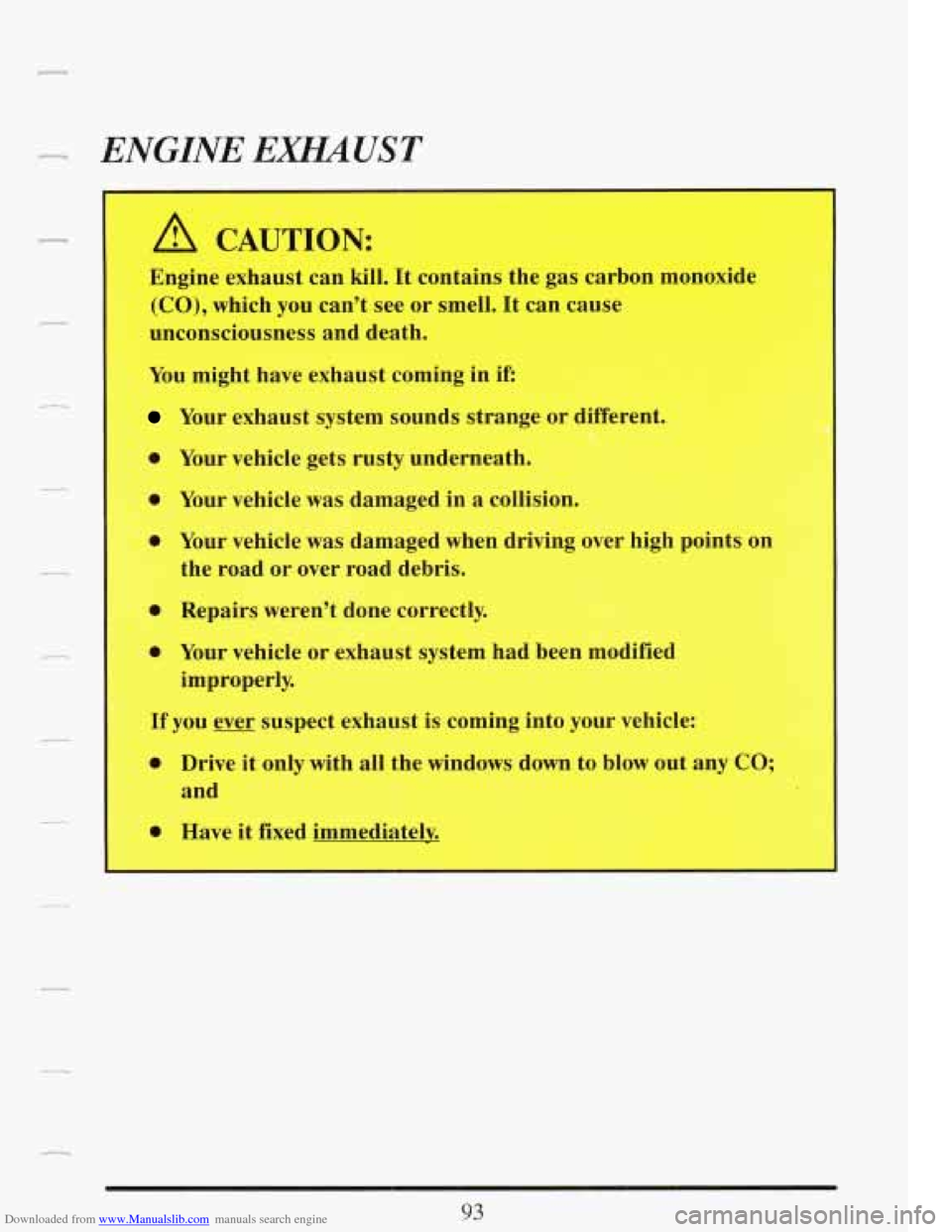
Downloaded from www.Manualslib.com manuals search engine r ENGINE EXHAUST
A CAUTION:
Engine exhaust can kill. It contains the gas carbon monoxide
(CO), which you can’t see or smell. It can cause
unconsciousness and death.
You might have exhaust coming in
if:
I
Your exhaust system sounds strange or 8di€ferent.
* Your vehicle gets rusty underneath.
a Your vehicle was damaged in a collision.
m
Your vehicle was damaged when drivingaver high points on
the road OF over mad debris.
0 Repairs weren’t dme correctiy :,* .
0 Your vehicle or exhalrst system had been modified
., -
improperly.
If you ever suspect exhaust is coming into your vehicle:
0 Drive it only with all the windows down to blow out any CO;
and
@ Have it fixed immediately.
93
Page 108 of 386

Downloaded from www.Manualslib.com manuals search engine RUNNING YOUR ENGINE WHILE YOU’RE
PARKED
It’s better not to park with the engine running. But if you ever have to,
here are some things to know.
A CAUTION:
Idling the engine with the air system control off could allow
dangerous exhaust
into your vehicle (see the earlier Caution
under “Engine Exhaust”).
Also, idling in a closed-in place can let deadly I- --moa monoxide
(CO) into your vehicle even if the fan switch is at the highest
setting. One place this
can happen is a garage. Exhaust -- with
CO -- can came in easily. NEWER park in. a garage with the
engine running.
Another
closed-in place can be a blizzard. (See “Blizzard” in the
Index,)
It can be dangerous to get out of your vehicle if the shift lever is
not fnhly in “P” (Park) with the parking brake firmly set. Your
vehicle can dI. l3on’t leave your vehicle when the engine is
running unless you have to. If you’ve left the engine running,
the vehicle can move suddenly. You or others could be injured.
Ta be $we your vehicle won’t move, even when you’re on fairly
level
ground, always set your parking brake move the shift lever
to “P” (Park). i
Follow the proper steps to be sure your vehicle won’t move,
If you ,am parking on zt hill, OT if you’re pulling a trailer, also see
“Parking on Hills” or “Towing a Ikrriler” in the Index.
94
- ’i LY
Page 109 of 386
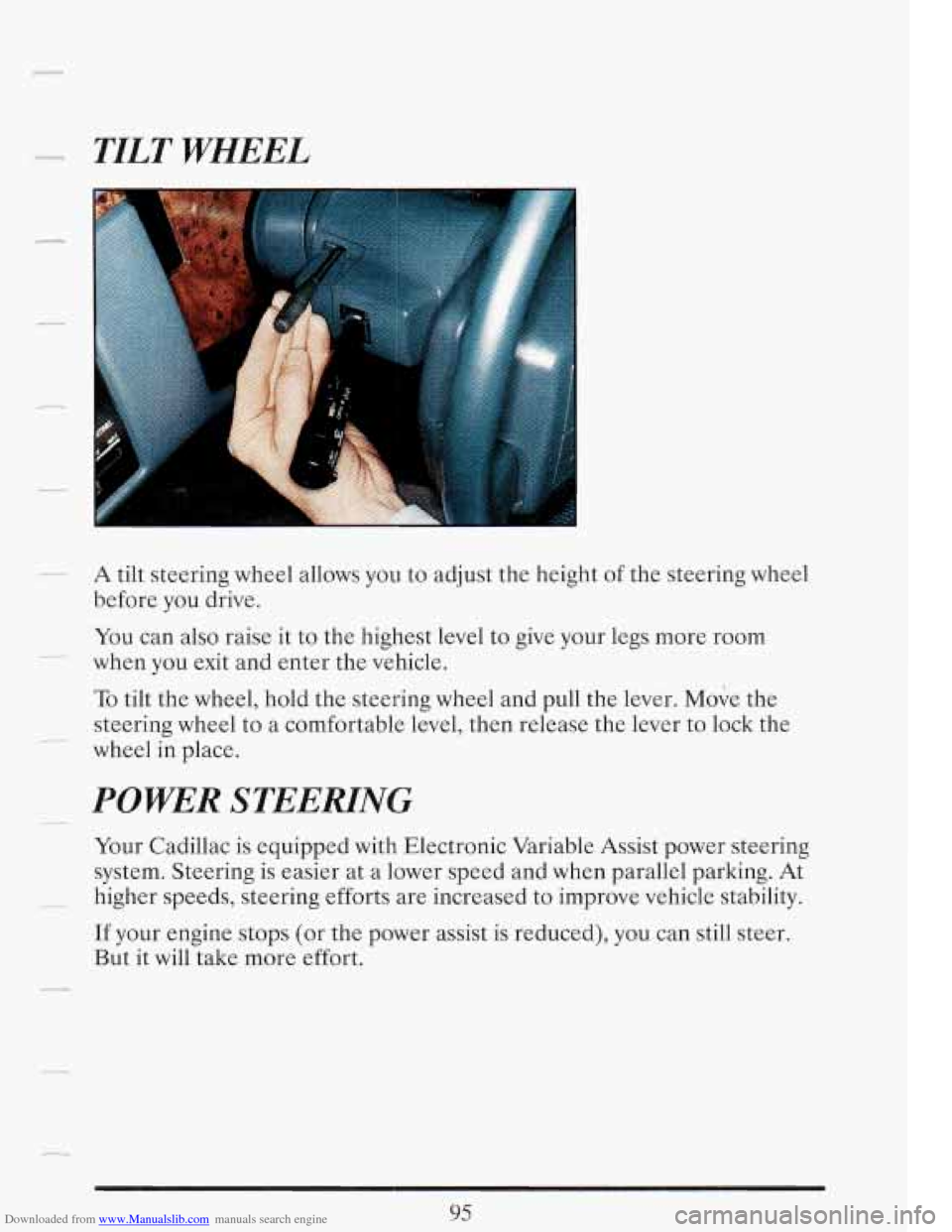
Downloaded from www.Manualslib.com manuals search engine _u_ TILT WHEEL
A tilt steering wheel allows you to adjust the height of the steering wheel
before you drive.
You can also raise it to the highest level to give your legs more room
when you exit and enter the vehicle.
g_
To tilt the wheel, hold the steering wheel and pull the lever. Move the
steering wheel to a comfortable level, then release the lever to lock the
wheel in place.
7
- POWER STEERING
Your Cadillac is equipped with Electronic Variable Assist power steering
system. Steering is easier at a lower speed and
when parallel parking. At
I_ higher speeds, steering efforts are increased to improve vehicle stability.
If your engine stops (or the power assist is reduced), you can still steer.
But it will take more effort.
95
Page 110 of 386
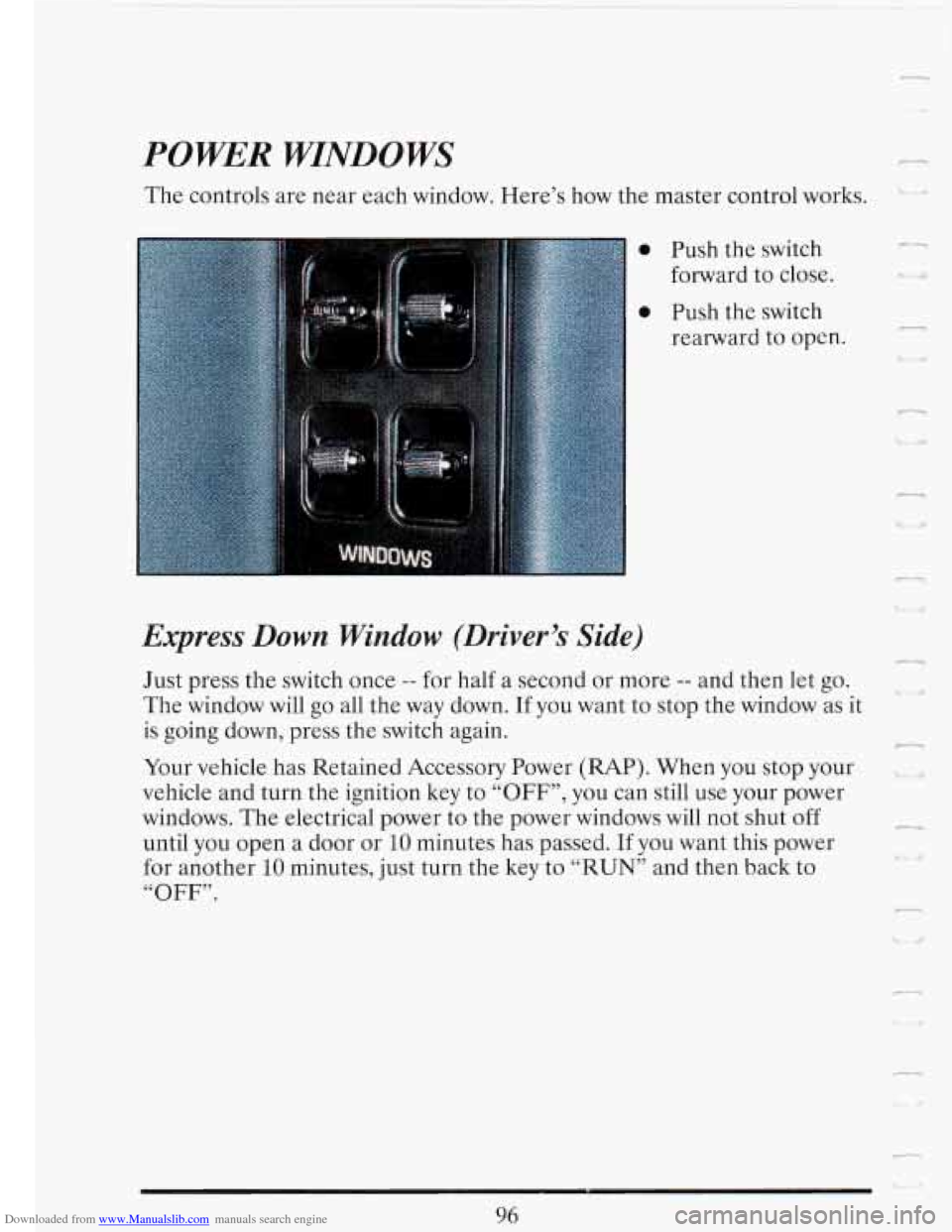
Downloaded from www.Manualslib.com manuals search engine POWER WTNDOWS
The controls are near each window. Here’s how the master control works.
Express Down Window (Driver’s Side)
n
Just press the switch once -- for half a second or more -- and then let go. 4
The window will go all the way down. If you want to stop the window as it
is going down, press the switch again.
Your vehicle has Retained Accessory Power
(RAP). When you stop your
vehicle and turn the ignition key to “OFF”, you can still use your power
windows. The electrical power to the power windows will not shut off
until you open a door or
10 minutes has passed. If you want this power
for another
10 minutes, just turn the key to “RUN’’ and then back to
“OFF”.
pi-